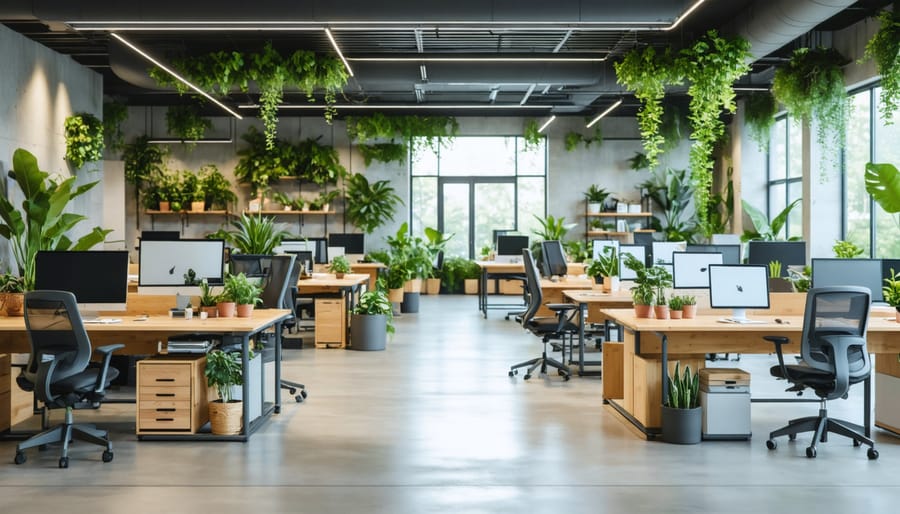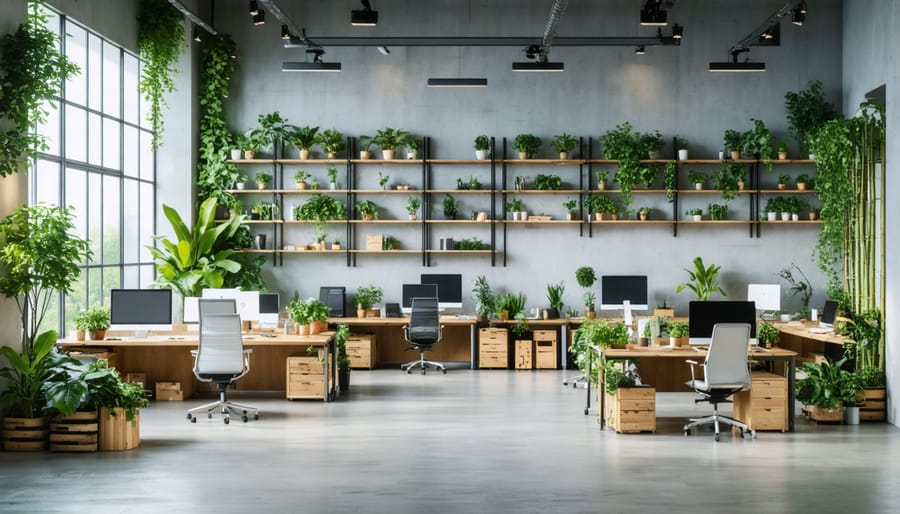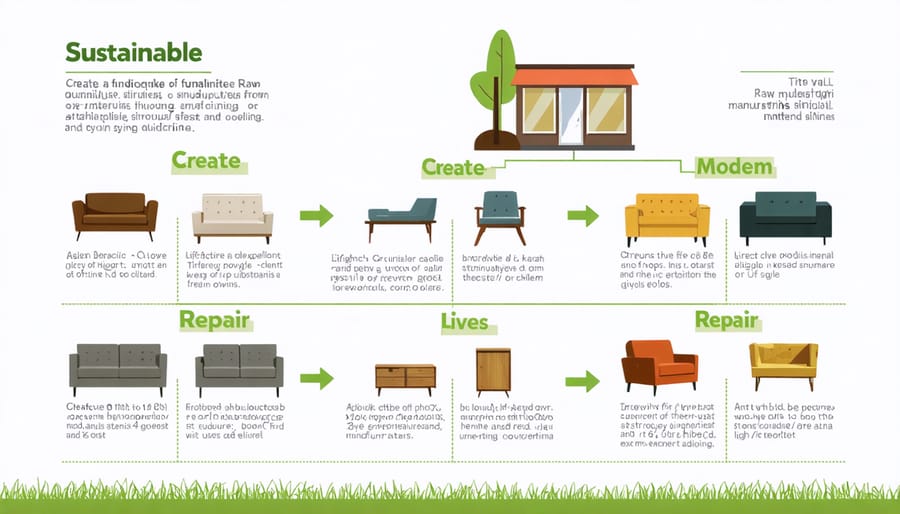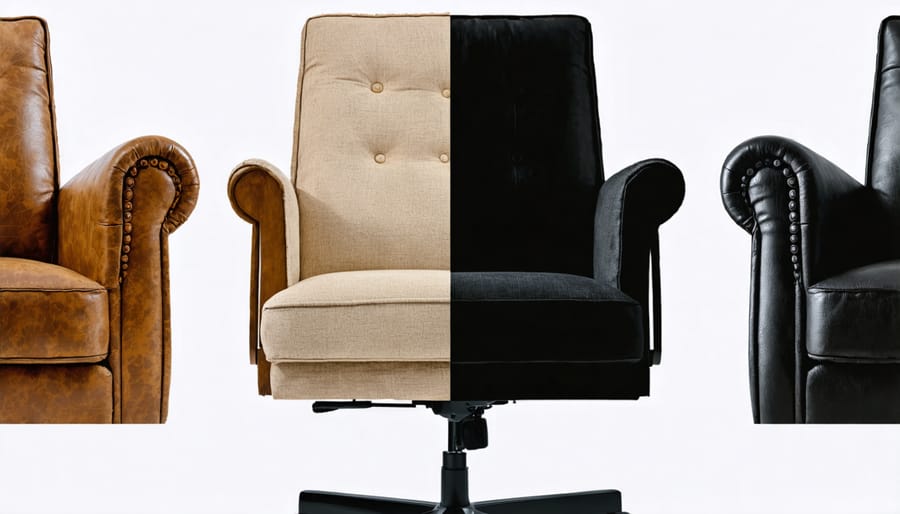
Sustainable commercial furniture stands at the intersection of environmental responsibility and smart business strategy, transforming how modern workplaces approach their furnishing decisions. Forward-thinking organizations now recognize that investing in eco-friendly furniture solutions delivers triple-bottom-line benefits: environmental conservation, enhanced employee wellbeing, and significant cost savings over time.
From recycled materials and biodegradable components to modular designs that adapt to changing workplace needs, sustainable commercial furniture represents a fundamental shift in how we equip our business spaces. Modern manufacturers are pioneering innovative solutions that combine durability with environmental stewardship, creating products that maintain high performance while minimizing ecological impact.
The market for sustainable commercial furniture has evolved beyond simple recycled materials, now encompassing circular economy principles, cradle-to-cradle design, and advanced manufacturing processes that reduce waste and energy consumption. For facility managers and business owners, this evolution presents an unprecedented opportunity to align operational needs with environmental goals while potentially reducing long-term costs through improved product longevity and reduced replacement needs.
This strategic approach to commercial furnishing not only supports corporate sustainability initiatives but also responds to growing employee and customer expectations for environmentally responsible business practices.

Investing in sustainable commercial furniture offers significant long-term financial advantages that saves your business money through multiple channels. High-quality sustainable furniture typically demonstrates superior durability, often lasting 10-15 years longer than conventional alternatives. This extended lifespan translates to reduced replacement costs and fewer procurement cycles.
Maintenance costs are notably lower with sustainable furniture pieces, as they’re designed with durability and ease of repair in mind. Many sustainable materials, such as bamboo and recycled metals, resist wear and tear better than traditional materials, requiring less frequent repairs and refinishing. This resilience means fewer maintenance calls and lower overall upkeep expenses.
Energy efficiency benefits also contribute to cost savings. Sustainable furniture often incorporates designs that maximize natural light usage and improve air circulation, potentially reducing heating and cooling costs. Additionally, pieces made with recycled or renewable materials typically require less energy to produce, leading to lower embodied energy costs.
When considering the total cost of ownership, sustainable furniture proves to be a smart financial decision. While initial investments might be higher, the combination of durability, reduced maintenance needs, and energy efficiency creates substantial savings over time, often delivering a positive return on investment within 3-5 years.
Investing in sustainable commercial furniture can yield significant financial benefits through various tax incentives and certification advantages. Many jurisdictions offer tax deductions and credits for businesses that implement environmentally friendly practices, including the use of sustainable furniture and materials.
The Federal Energy Policy Act provides tax deductions of up to $1.80 per square foot for commercial buildings that incorporate sustainable materials and energy-efficient solutions. State-level incentives vary but often include sales tax exemptions on certified sustainable furniture purchases and property tax abatements for green building improvements.
Sustainable furniture contributes valuable points toward LEED certification, helping buildings achieve or maintain their green building status. This certification can lead to increased property values, higher occupancy rates, and reduced operating costs. Additionally, buildings with WELL certification, which focuses on occupant health and wellness, benefit from sustainable furniture choices that meet low-emission and non-toxic material standards.
Energy Star certification programs also recognize businesses that use sustainable furniture as part of their overall environmental strategy. These certifications not only provide tax advantages but also enhance corporate reputation and help attract environmentally conscious tenants and employees.

Modern sustainable commercial furniture emphasizes environmentally responsible materials and manufacturing processes without compromising durability or aesthetics. Leading manufacturers are increasingly turning to recycled and renewable materials, including reclaimed wood, post-consumer plastics, and rapidly renewable resources like bamboo and cork.
FSC-certified wood ensures responsible forest management, while recycled metals and plastics reduce landfill waste and energy consumption. Many pieces now incorporate innovative materials such as bio-based foams, natural fibers, and non-toxic adhesives that minimize environmental impact while maintaining commercial-grade performance.
Manufacturing processes have evolved to embrace cleaner technologies and waste reduction strategies. Water-based finishes replace traditional solvent-based options, reducing volatile organic compound (VOC) emissions. Lean manufacturing principles help minimize waste, while modular design approaches facilitate easier repairs and component replacements, extending furniture lifespan.
Local sourcing of materials and components reduces transportation emissions and supports regional economies. Advanced cutting technologies maximize material yield, while closed-loop water systems and energy-efficient equipment reduce resource consumption. Many manufacturers now power their facilities with renewable energy and implement strict waste management protocols.
Quality control measures ensure that sustainable materials meet or exceed traditional durability standards, dispelling the myth that eco-friendly equals less durable. Third-party certifications like GREENGUARD and BIFMA level® provide independent verification of environmental claims and performance standards.
In today’s sustainability-focused market, the ability to repair and maintain commercial furniture is becoming increasingly vital. Choosing furniture that can be easily repaired not only extends its lifespan but also significantly reduces waste and environmental impact. Quality commercial furniture designed with furniture repair and restoration in mind often features replaceable components, modular designs, and durable materials that withstand regular use.
Consider furniture pieces with standardized parts that can be easily sourced and replaced when needed. This approach ensures that a single damaged component doesn’t condemn an entire piece to the landfill. Look for manufacturers who provide comprehensive care guides, maintenance schedules, and readily available replacement parts.
Features that enhance repairability include removable upholstery, replaceable seat cushions, and serviceable mechanical parts. These elements make it possible to address wear and tear without replacing entire furniture pieces. Additionally, choosing furniture made from solid materials like hardwood, metal, or high-grade plastics ensures that repairs are more feasible and effective.
Investing in repairable furniture often results in lower total ownership costs despite higher initial prices. Regular maintenance and timely repairs can extend furniture life by decades, making it a sound financial and environmental choice. Many manufacturers now offer warranties that include repair services, demonstrating their commitment to product longevity.
When considering sustainable commercial furniture, end-of-life management is crucial for minimizing environmental impact. Forward-thinking businesses are increasingly adopting furniture waste reduction strategies that extend beyond simple disposal.
Many manufacturers now design furniture with recyclability in mind, using materials that can be easily separated and processed. Metal components, such as aluminum and steel frames, are nearly 100% recyclable. Wood elements can be repurposed into particleboard or biomass fuel, while certain plastics can be transformed into new products through specialized recycling processes.
Several innovative disposal options are available for commercial furniture at the end of its lifecycle. Furniture take-back programs, offered by leading manufacturers, ensure proper dismantling and recycling of components. Local recycling facilities often accept specific furniture materials, while donation programs provide opportunities to extend furniture life through charitable organizations.
To maximize sustainability, businesses should plan for furniture end-of-life during the initial procurement process. Consider selecting pieces with modular designs that allow for easy disassembly and component replacement. Document material composition and keep assembly instructions to facilitate future recycling efforts. Partner with certified recycling facilities or furniture refurbishment specialists who can properly handle various materials and ensure minimal landfill impact.
By implementing thoughtful end-of-life strategies, organizations can significantly reduce their environmental footprint while potentially recovering value from their furniture investments.
Begin your sustainable furniture journey with a thorough assessment of your current commercial furniture inventory. Create a detailed spreadsheet documenting each piece’s condition, age, materials, and expected lifespan. Consider factors like repair potential, maintenance costs, and environmental impact when evaluating replacement needs.
When planning sustainable replacements, prioritize items based on both necessity and environmental benefit. Look for furniture certified by recognized environmental standards such as FSC (Forest Stewardship Council) or GREENGUARD. Consider the full lifecycle of potential purchases, including manufacturing processes, transportation distances, and end-of-life disposal options.
Develop a phased replacement strategy that aligns with your budget and sustainability goals. Calculate the return on investment by factoring in durability, maintenance requirements, and potential energy savings from ergonomic designs. Consider modular furniture options that can be easily reconfigured or upgraded rather than replaced entirely.
Create a timeline for implementation, including specific milestones and success metrics. Engage stakeholders early in the planning process to ensure buy-in and gather valuable input on functionality requirements. Remember to document your sustainable furniture choices to support future environmental reporting and certification efforts.
When selecting suppliers for sustainable commercial furniture, start by evaluating their commitment to sustainable commercial design through their certifications and practices. Look for manufacturers with recognized environmental certifications such as FSC (Forest Stewardship Council), GREENGUARD, or Level® certification from BIFMA.
Research their material sourcing practices and verify they use recycled or renewable materials whenever possible. Request documentation about their supply chain transparency and ask about their waste reduction initiatives. Reliable suppliers should be able to provide detailed information about their manufacturing processes and environmental impact metrics.
Consider suppliers who offer take-back programs or end-of-life furniture solutions. These programs demonstrate a commitment to circular economy principles and help reduce waste. Additionally, evaluate their local presence – working with nearby manufacturers can reduce transportation emissions and support regional economies.
Review their product warranties and maintenance requirements, as durable furniture that lasts longer ultimately creates less environmental impact. Finally, ask for references from other commercial clients and examine their portfolio of sustainable projects to ensure they have a proven track record of delivering environmentally responsible furniture solutions.
Regular maintenance is crucial for extending the lifespan of sustainable commercial furniture and preserving its eco-friendly benefits. Start by implementing a routine cleaning schedule using green-certified products that are both effective and environmentally responsible. Dust furniture weekly with microfiber cloths, and address spills immediately to prevent staining and material degradation.
For wooden pieces, apply natural furniture oils quarterly to maintain moisture levels and prevent cracking. Metal components should be inspected monthly for signs of corrosion, especially in humid environments. Upholstered items benefit from bi-annual professional cleaning using low-impact, water-based solutions.
Keep furniture away from direct sunlight and maintain consistent indoor humidity levels between 40-60% to prevent warping and material stress. Regularly check and tighten hardware connections, particularly on frequently used pieces like chairs and tables. Consider applying protective coatings made from sustainable materials to high-wear surfaces.
Train staff on proper furniture handling and usage to minimize unnecessary wear and tear. Document all maintenance activities and create a schedule for professional assessments to catch potential issues early, ensuring your sustainable furniture investment maintains its value and environmental benefits for years to come.

The transformation of Adobe’s San Jose headquarters showcases the power of sustainable commercial furniture in action. In 2019, the tech giant partnered with sustainable furniture manufacturer Steelcase to outfit their 2.1 million square foot campus. By choosing furniture made from recycled materials and implementing a furniture lifecycle management program, Adobe reduced their furniture-related carbon footprint by 40% while saving $2.5 million in procurement costs.
WeWork’s global co-working spaces demonstrate another successful implementation of sustainable furniture strategies. Their London locations feature modular furniture systems from Interface, constructed using recycled ocean plastics and bio-based materials. This initiative not only resonated with their environmentally conscious members but also resulted in a 30% reduction in furniture replacement costs over two years.
Seattle-based law firm Davis Wright Tremaine made headlines when they renovated their offices with locally sourced, FSC-certified furniture. Working with sustainable furniture designer Herman Miller, they created an office environment that improved employee satisfaction by 45% while reducing their furniture disposal waste by 75%. The firm’s innovative furniture lease-to-own program ensures responsible end-of-life management for all pieces.
The Bank of Melbourne’s sustainable furniture program demonstrates the financial viability of eco-friendly choices. Their 2020 branch redesign featuring cradle-to-cradle certified furniture resulted in a 35% increase in customer dwell time and a 20% reduction in maintenance costs. The bank’s furniture includes pieces made from reclaimed materials and features modular designs that can be easily refurbished or repurposed, extending their useful life by an average of seven years.
Sustainable commercial furniture represents a crucial investment in both environmental stewardship and business success. By choosing eco-friendly materials, prioritizing durability, and working with certified manufacturers, organizations can significantly reduce their environmental impact while creating healthier, more productive workspaces. The benefits extend beyond environmental considerations, offering substantial cost savings through reduced replacement cycles and enhanced employee satisfaction.
For businesses ready to embrace sustainable furniture solutions, the journey begins with a thorough assessment of current needs and future growth plans. Start by identifying key sustainability certifications and establishing relationships with reputable manufacturers who share your environmental values. Consider implementing a pilot program in one department or area before scaling across your entire facility.
Remember to document your sustainable furniture initiatives and communicate their impact to stakeholders. This transparency not only demonstrates corporate responsibility but also inspires others to follow suit. By making informed decisions about sustainable commercial furniture today, businesses can create lasting positive change for tomorrow while maintaining their competitive edge in an increasingly environmentally conscious marketplace.